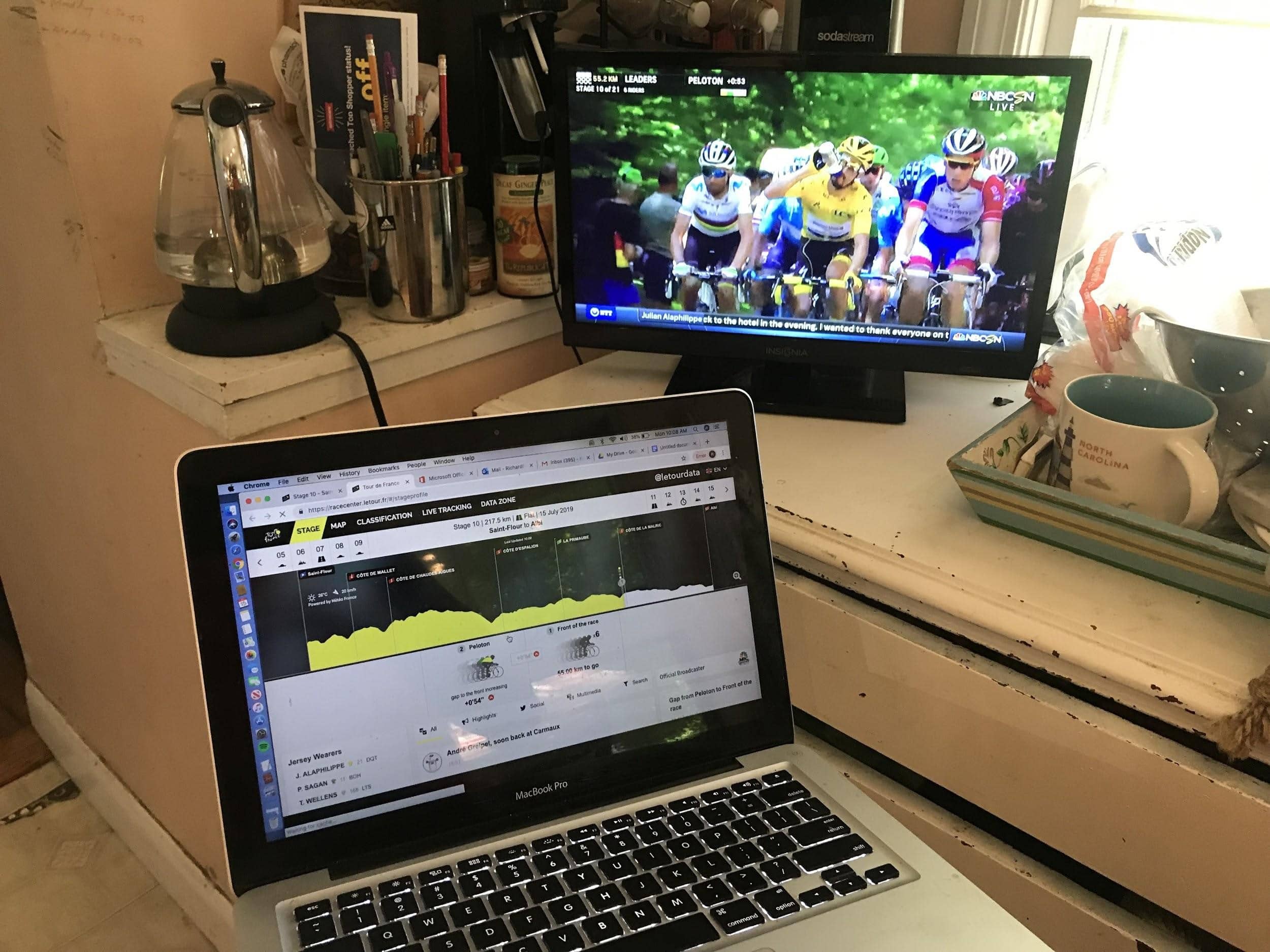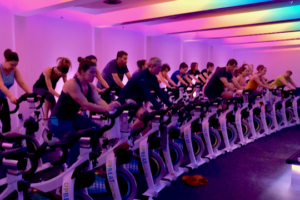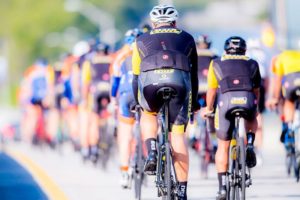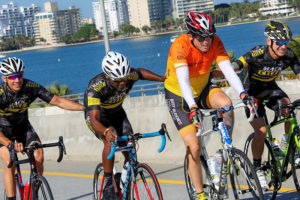Lessons from the Tour de France
Charity Cyclists Can Learn from ‘Le Grand Boucle’

The soundtrack to my life in July is that of Englishman Phil Liggett calling the Tour de France on television. While I work on the main laptop I keep a second laptop dedicated to the LeTour.com Race Center.
For an American fan of bleacher sports, of which I am one, the Tour may seem confusing in that while there are no timeouts or half-times. While the thrills and spills can happen at any second, there are extended periods that are hardly edge-of-your-seat excitement. When I did television work a producer once complimented cycling for its resemblance to baseball. Initially insulted by the association of my beloved and savage test of souls with a softer and slower game of skill, I begged for an explanation.
“Both are sports that take time to develop and then have amazingly crucial moments,” he noted.
He was right. Baseball moves painfully slow until – with a few bumbles or bats – the bases are loaded, the pitcher is collapsing, and Mighty Casey comes to bat. Watching pro cycling, especially a stage race, is a lot like watching storm clouds form knowing that lightning will strike but not knowing necessarily when or where. And I follow it with the zeal of meteorologist.
While the Tour de France may not be the greatest spectator event in cycling, it captures the world’s fascination for several reasons. The biggest of those is that it owns July, with only Wimbledon and the British Open to compete for attention. July is when much of the world is on holiday, capable of following a three-week parade.
To watch the world’s largest annual sporting event requires a bit of education. But with television and the Internet the sport speaks to the follower in a curious language that, after initial puzzlement, becomes understood seemingly at once. Like Keanu Reeve’s character Neo in The Matrix, the Tour’s colors, shapes and numbers suddenly present themselves in a patterned bloom of energy. The same revelation occurs in most stick-and-ball sports: we can see the blitz coming, the pick and roll, the shift of the infield. But in cycling this unfolds amid not a static, measured court but woven amid natural, cultural and geologic splendor.
That moment is athletic rapture.
So what can a charity cyclist learn from watching the Tour de France? Here are just 10 things (of which there are hundreds) to consider when watching Le Tour in July.
- Preparation is Key. The top riders surround themselves with incredible “domestiques” (servant riders), “soigneurs” (caretakers), mechanics, cooks, staff and directors who manage all these details. YOUR TAKEAWAY: LOGISTICS ARE AS IMPORTANT AS FITNESS.
- Position and Fit Matter. Watch the field and note how every rider pretty much sits on the bike with the same form and pedals at roughly the same cadence.The handlebars and saddle are relatively the same regardless of their respective size. They are not set up in ridiculous positions to be aero but to be comfortable, efficient, nimble and safe. YOUR TAKEAWAY: A GOOD BIKE FIT MAKES YOU SAFER IN A GROUP AND MORE COMFORTABLE ON A LONG RIDE.
- Less is More. Aside from radios and a simple cycle-computer, they have almost nothing to complicate matters. No goofy iPad, no mirrors, no extra baggage. Everything fits in the back pockets of their kits. YOUR TAKEAWAY: PARE DOWN TO THE ESSENTIALS.
- Eyes Forward. Many are intimidated by riding within that pincushion of bodies and bikes, over hill and dale, into compact cities and towns, through rotaries and amid a caravan of cars, motorcycles and spectators. The secret? Keep your eyes forward. Note that no Tour de France rider has a mirror. Nothing behind them causes problems. So many things ahead can do so. YOUR TAKEAWAY: KEEP YOUR EYES ON THE ROAD.
- Hands are as Important as Legs. Watch these riders grabbing bottles, shifting, feed bags, donning or disrobing rain clothing, reaching in and out of their pockets, braking, signalling, and constantly using their hands to guide them and their fellow riders through tight spots. YOUR TAKEAWAY: HAVING LIGHT HANDS ENABLES YOU TO STAY EFFICIENT, FED, HYDRATED AND SAFE.
- Recovery and Nutrition is Critical. To survive any stage race, let alone a three-week Grand Tour, these riders are careful to get off their bike, out of their wet clothes, fed, hydrated, and off their legs immediately. And, they stay off their legs right up until the next day’s stage. YOUR TAKEAWAY: YOUR TRAINING IS ONLY AS GOOD AS THE RECOVERY PROCESS.
- Note the Weather. These riders never seem to be surprised by changes in the weather. Watching them train through the winter, tackle cyclo-cross, or race the spring classics you see them all properly dressed and equipped. Stage 10 of this year’s race, however, showcased how prepared they were about something else: the wind. When the seemingly benign course hit a crosswind, the field exploded into pieces with several favorites caught off guard and left behind. YOUR TAKEAWAY: BE PREPARED FOR EVERY WEATHER CONTINGENCY.
- It’s All About the Group. Note the cooperation of the breakaway riders, who form a temporary alliance despite differing team affiliations. Note how the field moves like an organism, often as a large confederacy, with assorted shapes in response to changes in the roadway, the race tactics, or conditions. They share. They signal truces. There is etiquette. Then note the sheer power of a large group that can ride smoothly at speed, fomenting a cascade of speed, devouring a breakaway group’s four-minute advantage with a steady surge in the final 10 kilometer. YOUR TAKEAWAY: TO RIDE WITH EASE, LEARN TO RIDE IN A LARGE GROUP.
- Go Easy When it’s Hard; Hard When it’s Easy. There is enormous focus by entry level fans of cycling to zero in on the “HTFU” moments in the Tour de France, those severe mountain top finishes with chaotic fans and motorcycles and cars and cameras. For the overall contenders, maybe 10 percent of the racing experience is that critical offense. But so much of the sport is defense. The key is to work hard only when one must. While a mortal cyclist would be smashed simply riding a single Alpine climb of Le Tour, these riders manage stage after stage with as many as seven categorized climbs. The key? They don’t ALWAYS go so hard as to blow up the group, their team or their own body. They climb steadily uphill but then roll really fast on the downhill, all to keep the group together. This is how a breakaway, the main field and especially the riders in the “Autobus” or “Grupetto” (those riders who collaborate to make each day’s time cut) survive. YOUR TAKEAWAY: RIDE AT A MANAGEABLE PACE TO KEEP YOUR GROUP TOGETHER. YOU’LL GET THERE FASTER.
- It’s Freakin’ France! This event is the greatest postcard ever invented for arguably the most beautiful country in the world. As sentimental as I can get over Fenway Park or Wrigley Field, nothing else in sport matches the splendor of the Tour de France. But cycling everywhere offers us a sensory buffet to enjoy. YOUR TAKEAWAY: REMEMBER THAT EVEN AT ITS MOST BRUTAL EXTREME, CYCLING IS STILL A ‘TOUR’. ENJOY THE RIDE.
 Richard Fries is the Director of Cycling Experience for the Best Buddies Challenges. With more than 40 years experience, he has been a racer, commuter, tourist, promoter, advocate, journalist and commentator on the sport and lifestyle of cycling. Having raced at the professional level both in America and Europe, Fries is well known as a race announcer having called countless USA Cycling National Championships, World Cups, and UCI World Championships. But he is also a tireless advocate having recently served as the executive director of MassBike. You can follow him on Strava to learn more.
Richard Fries is the Director of Cycling Experience for the Best Buddies Challenges. With more than 40 years experience, he has been a racer, commuter, tourist, promoter, advocate, journalist and commentator on the sport and lifestyle of cycling. Having raced at the professional level both in America and Europe, Fries is well known as a race announcer having called countless USA Cycling National Championships, World Cups, and UCI World Championships. But he is also a tireless advocate having recently served as the executive director of MassBike. You can follow him on Strava to learn more.




